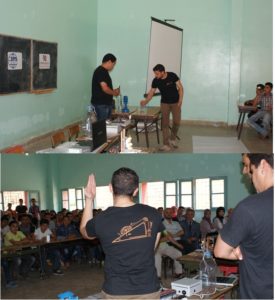 Mghila Béni Mellal USMS section has set up several activities during the 2017. First, visits to schools in Beni Mellal region and the realization of solar tracer project.
Mghila Béni Mellal USMS section has set up several activities during the 2017. First, visits to schools in Beni Mellal region and the realization of solar tracer project.
The focus of our activities is the transmission of technology to high school students and author people, and to show them how they can make practical works and technical projects with simple components and low cost.
First, we have visited a high school in AitAtab (Beni Mellal) and organizing a workshop of science and technology, in this workshop, we try to approach young minds students to technology and how to make a project with simple components and simple acknowledge. These projects are Cnc plotter, line tracer robot, robotic arm, alarm system. We have also visited another school in Fkih Beni Salh, where we organized a great event for more than 300 students from different levels. The objective of this event is show to student how to make a station to measuring some physical magnitudes, and use these measurements to make some simple project. For example Temperature measurement, this system is used to measure the temperature is composed by temperature sensor, Arduino board and an interface to visualize the results, we usually used LabViwe software. An author example is the radiation measurement this system is used to measure the solar radiation by using solar cells sensor.
The students shown great interest in the experiments and greatly thanked our visit, these students really got involved in the activities and due to that, we think they have learned many things. We considered this a very fruitful visit, were we gained also experience in presenting for large audiences.
The second Activity is the realization of a mono-axial solar tracker. The technique used for this study is based on the incident light difference on light-dependent photoresistor (LDR) sensors separated by opaque walls and placed on the PV panel. The control and control circuit performs the function of comparing the signals emitted by the sensors by calculating their differences, and then sends impulses back to the motor to reposition the panel perpendicular to the solar rays. We used in the realization of this project a stepper motor a support of two panels a control circuit composed of an Arduino acquisition card and two photoresistances.
